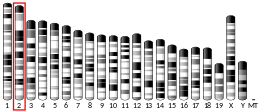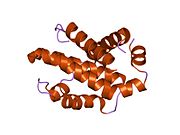Bcl-2유사단백질1
Bcl-2-like protein 1BCL-2 유사단백질 1은 BCL2L1 유전자에 의해 인간에게 코드되는 단백질이다.대체 스플라이싱을 통해 이 유전자는 인간 단백질 Bcl-xL과 Bcl-xS를 [5]모두 암호화한다.
기능.
이 유전자에 의해 암호화된 단백질은 Bcl-2 단백질군에 속합니다.Bcl-2 패밀리는 헤테로 또는 호모디머를 형성하고 광범위한 세포 활동에 관여하는 항아포토시스 조절제 또는 항아포토시스 조절제 역할을 한다.이 유전자에 의해 암호화된 단백질은 미토콘드리아 외막에 위치하고 있으며, 미토콘드리아 외막 채널(전압의존성 음이온 채널(VDACs)) 개방을 조절하는 것으로 나타났다.VDAC는 미토콘드리아 막 전위를 조절하고, 따라서 미토콘드리아에 의한 활성산소의 생성과 시토크롬C의 방출을 통제하며, 두 가지 모두 세포자멸의 잠재적 유도체이다.서로 다른 Isoform을 인코딩하는 두 가지 대체 스플라이스된 전사 변형이 보고되었다.긴 아이소폼(Bcl-xL)은 아포토시스 억제제,[5][6] 짧은 아이소폼(Bcl-xS)은 아포토시스 활성제 역할을 한다.
상호 작용
BCL2와 같은 1(유전자)은 다음과 상호작용하는 것으로 나타났다.
- APAF1,[7][8]
- BAK1,[9][10][11][12][13]
- BCAP31,[14]
- BCL2L11,[11][15][16][17]
- BNIP3,[18]
- BNIPL,[19][20]
- 불량[10][15][21][22][23][24][25][26][27][28][29]
- 백스[10][22][30][31]
- 비크,[9][15][31][32]
- BCL-2,[10][33]
- HRK,[11][34][35]
- IKZF3,[36]
- 녹사[15][37]
- PPP1CA,[23]
- PSEN2[38]
- RAD9A,[9][21]
- RTN1,[39]
- RTN4 [39]및
- VDAC1.[40][41][42][43]
레퍼런스
- ^ a b c GRCh38: 앙상블 릴리즈 89: ENSG00000171552: 앙상블, 2017년 5월
- ^ a b c GRCm38: 앙상블 릴리즈 89: ENSMUSG00000007659 - 앙상블, 2017년 5월
- ^ "Human PubMed Reference:". National Center for Biotechnology Information, U.S. National Library of Medicine.
- ^ "Mouse PubMed Reference:". National Center for Biotechnology Information, U.S. National Library of Medicine.
- ^ a b Boise LH, González-García M, Postema CE, Ding L, Lindsten T, Turka LA, Mao X, Nuñez G, Thompson CB (Aug 1993). "bcl-x, a bcl-2-related gene that functions as a dominant regulator of apoptotic cell death" (PDF). Cell. 74 (4): 597–608. doi:10.1016/0092-8674(93)90508-N. hdl:2027.42/30629. PMID 8358789. S2CID 13542617.
- ^ "Entrez Gene: BCL2L1 BCL2-like 1".
- ^ Hu Y, Benedict MA, Wu D, Inohara N, Núñez G (Apr 1998). "Bcl-XL interacts with Apaf-1 and inhibits Apaf-1-dependent caspase-9 activation". Proceedings of the National Academy of Sciences of the United States of America. 95 (8): 4386–91. Bibcode:1998PNAS...95.4386H. doi:10.1073/pnas.95.8.4386. PMC 22498. PMID 9539746.
- ^ Pan G, O'Rourke K, Dixit VM (Mar 1998). "Caspase-9, Bcl-XL, and Apaf-1 form a ternary complex". The Journal of Biological Chemistry. 273 (10): 5841–5. doi:10.1074/jbc.273.10.5841. PMID 9488720.
- ^ a b c Rual JF, Venkatesan K, Hao T, Hirozane-Kishikawa T, Dricot A, Li N, Berriz GF, Gibbons FD, Dreze M, Ayivi-Guedehoussou N, Klitgord N, Simon C, Boxem M, Milstein S, Rosenberg J, Goldberg DS, Zhang LV, Wong SL, Franklin G, Li S, Albala JS, Lim J, Fraughton C, Llamosas E, Cevik S, Bex C, Lamesch P, Sikorski RS, Vandenhaute J, Zoghbi HY, Smolyar A, Bosak S, Sequerra R, Doucette-Stamm L, Cusick ME, Hill DE, Roth FP, Vidal M (Oct 2005). "Towards a proteome-scale map of the human protein-protein interaction network". Nature. 437 (7062): 1173–8. Bibcode:2005Natur.437.1173R. doi:10.1038/nature04209. PMID 16189514. S2CID 4427026.
- ^ a b c d Zhang H, Nimmer P, Rosenberg SH, Ng SC, Joseph M (Aug 2002). "Development of a high-throughput fluorescence polarization assay for Bcl-x(L)". Analytical Biochemistry. 307 (1): 70–5. doi:10.1016/S0003-2697(02)00028-3. PMID 12137781.
- ^ a b c Whitfield J, Harada K, Bardelle C, Staddon JM (Nov 2003). "High-throughput methods to detect dimerization of Bcl-2 family proteins". Analytical Biochemistry. 322 (2): 170–8. doi:10.1016/j.ab.2003.07.014. PMID 14596824.
- ^ Willis SN, Chen L, Dewson G, Wei A, Naik E, Fletcher JI, Adams JM, Huang DC (Jun 2005). "Proapoptotic Bak is sequestered by Mcl-1 and Bcl-xL, but not Bcl-2, until displaced by BH3-only proteins". Genes & Development. 19 (11): 1294–305. doi:10.1101/gad.1304105. PMC 1142553. PMID 15901672.
- ^ Degterev A, Lugovskoy A, Cardone M, Mulley B, Wagner G, Mitchison T, Yuan J (Feb 2001). "Identification of small-molecule inhibitors of interaction between the BH3 domain and Bcl-xL". Nature Cell Biology. 3 (2): 173–82. doi:10.1038/35055085. PMID 11175750. S2CID 32934759.
- ^ Ng FW, Nguyen M, Kwan T, Branton PE, Nicholson DW, Cromlish JA, Shore GC (Oct 1997). "p28 Bap31, a Bcl-2/Bcl-XL- and procaspase-8-associated protein in the endoplasmic reticulum". The Journal of Cell Biology. 139 (2): 327–38. doi:10.1083/jcb.139.2.327. PMC 2139787. PMID 9334338.
- ^ a b c d Chen L, Willis SN, Wei A, Smith BJ, Fletcher JI, Hinds MG, Colman PM, Day CL, Adams JM, Huang DC (Feb 2005). "Differential targeting of prosurvival Bcl-2 proteins by their BH3-only ligands allows complementary apoptotic function". Molecular Cell. 17 (3): 393–403. doi:10.1016/j.molcel.2004.12.030. PMID 15694340.
- ^ O'Connor L, Strasser A, O'Reilly LA, Hausmann G, Adams JM, Cory S, Huang DC (Jan 1998). "Bim: a novel member of the Bcl-2 family that promotes apoptosis". The EMBO Journal. 17 (2): 384–95. doi:10.1093/emboj/17.2.384. PMC 1170389. PMID 9430630.
- ^ Hsu SY, Lin P, Hsueh AJ (Sep 1998). "BOD (Bcl-2-related ovarian death gene) is an ovarian BH3 domain-containing proapoptotic Bcl-2 protein capable of dimerization with diverse antiapoptotic Bcl-2 members". Molecular Endocrinology. 12 (9): 1432–40. doi:10.1210/mend.12.9.0166. PMID 9731710.
- ^ Ray R, Chen G, Vande Velde C, Cizeau J, Park JH, Reed JC, Gietz RD, Greenberg AH (Jan 2000). "BNIP3 heterodimerizes with Bcl-2/Bcl-X(L) and induces cell death independent of a Bcl-2 homology 3 (BH3) domain at both mitochondrial and nonmitochondrial sites". The Journal of Biological Chemistry. 275 (2): 1439–48. doi:10.1074/jbc.275.2.1439. PMID 10625696.
- ^ Qin W, Hu J, Guo M, Xu J, Li J, Yao G, Zhou X, Jiang H, Zhang P, Shen L, Wan D, Gu J (Aug 2003). "BNIPL-2, a novel homologue of BNIP-2, interacts with Bcl-2 and Cdc42GAP in apoptosis". Biochemical and Biophysical Research Communications. 308 (2): 379–85. doi:10.1016/S0006-291X(03)01387-1. PMID 12901880.
- ^ Yasuda M, Han JW, Dionne CA, Boyd JM, Chinnadurai G (Feb 1999). "BNIP3alpha: a human homolog of mitochondrial proapoptotic protein BNIP3". Cancer Research. 59 (3): 533–7. PMID 9973195.
- ^ a b Komatsu K, Miyashita T, Hang H, Hopkins KM, Zheng W, Cuddeback S, Yamada M, Lieberman HB, Wang HG (Jan 2000). "Human homologue of S. pombe Rad9 interacts with BCL-2/BCL-xL and promotes apoptosis". Nature Cell Biology. 2 (1): 1–6. doi:10.1038/71316. PMID 10620799. S2CID 52847351.
- ^ a b Strobel T, Tai YT, Korsmeyer S, Cannistra SA (Nov 1998). "BAD partly reverses paclitaxel resistance in human ovarian cancer cells". Oncogene. 17 (19): 2419–27. doi:10.1038/sj.onc.1202180. PMID 9824152.
- ^ a b Ayllón V, Cayla X, García A, Fleischer A, Rebollo A (Jul 2002). "The anti-apoptotic molecules Bcl-xL and Bcl-w target protein phosphatase 1alpha to Bad". European Journal of Immunology. 32 (7): 1847–55. doi:10.1002/1521-4141(200207)32:7<1847::AID-IMMU1847>3.0.CO;2-7. PMID 12115603.
- ^ Jin Z, Xin M, Deng X (Apr 2005). "Survival function of protein kinase C{iota} as a novel nitrosamine 4-(methylnitrosamino)-1-(3-pyridyl)-1-butanone-activated bad kinase". The Journal of Biological Chemistry. 280 (16): 16045–52. doi:10.1074/jbc.M413488200. PMID 15705582.
- ^ Yang E, Zha J, Jockel J, Boise LH, Thompson CB, Korsmeyer SJ (Jan 1995). "Bad, a heterodimeric partner for Bcl-XL and Bcl-2, displaces Bax and promotes cell death". Cell. 80 (2): 285–91. doi:10.1016/0092-8674(95)90411-5. PMID 7834748. S2CID 10343291.
- ^ Petros AM, Nettesheim DG, Wang Y, Olejniczak ET, Meadows RP, Mack J, Swift K, Matayoshi ED, Zhang H, Thompson CB, Fesik SW (Dec 2000). "Rationale for Bcl-xL/Bad peptide complex formation from structure, mutagenesis, and biophysical studies". Protein Science. 9 (12): 2528–34. doi:10.1110/ps.9.12.2528. PMC 2144516. PMID 11206074.
- ^ Chattopadhyay A, Chiang CW, Yang E (Jul 2001). "BAD/BCL-[X(L)] heterodimerization leads to bypass of G0/G1 arrest". Oncogene. 20 (33): 4507–18. doi:10.1038/sj.onc.1204584. PMID 11494146.
- ^ Iwahashi H, Eguchi Y, Yasuhara N, Hanafusa T, Matsuzawa Y, Tsujimoto Y (Nov 1997). "Synergistic anti-apoptotic activity between Bcl-2 and SMN implicated in spinal muscular atrophy". Nature. 390 (6658): 413–7. Bibcode:1997Natur.390..413I. doi:10.1038/37144. PMID 9389483. S2CID 1936633.
- ^ Komatsu K, Wharton W, Hang H, Wu C, Singh S, Lieberman HB, Pledger WJ, Wang HG (Nov 2000). "PCNA interacts with hHus1/hRad9 in response to DNA damage and replication inhibition". Oncogene. 19 (46): 5291–7. doi:10.1038/sj.onc.1203901. PMID 11077446.
- ^ Sedlak TW, Oltvai ZN, Yang E, Wang K, Boise LH, Thompson CB, Korsmeyer SJ (Aug 1995). "Multiple Bcl-2 family members demonstrate selective dimerizations with Bax". Proceedings of the National Academy of Sciences of the United States of America. 92 (17): 7834–8. Bibcode:1995PNAS...92.7834S. doi:10.1073/pnas.92.17.7834. PMC 41240. PMID 7644501.
- ^ a b Gillissen B, Essmann F, Graupner V, Stärck L, Radetzki S, Dörken B, Schulze-Osthoff K, Daniel PT (Jul 2003). "Induction of cell death by the BH3-only Bcl-2 homolog Nbk/Bik is mediated by an entirely Bax-dependent mitochondrial pathway". The EMBO Journal. 22 (14): 3580–90. doi:10.1093/emboj/cdg343. PMC 165613. PMID 12853473.
- ^ Jiang A, Clark EA (May 2001). "Involvement of Bik, a proapoptotic member of the Bcl-2 family, in surface IgM-mediated B cell apoptosis". Journal of Immunology. 166 (10): 6025–33. doi:10.4049/jimmunol.166.10.6025. PMID 11342619.
- ^ Lin B, Kolluri SK, Lin F, Liu W, Han YH, Cao X, Dawson MI, Reed JC, Zhang XK (Feb 2004). "Conversion of Bcl-2 from protector to killer by interaction with nuclear orphan receptor Nur77/TR3". Cell. 116 (4): 527–40. doi:10.1016/S0092-8674(04)00162-X. PMID 14980220. S2CID 17808479.
- ^ Inohara N, Ding L, Chen S, Núñez G (Apr 1997). "harakiri, a novel regulator of cell death, encodes a protein that activates apoptosis and interacts selectively with survival-promoting proteins Bcl-2 and Bcl-X(L)". The EMBO Journal. 16 (7): 1686–94. doi:10.1093/emboj/16.7.1686. PMC 1169772. PMID 9130713.
- ^ Imaizumi K, Morihara T, Mori Y, Katayama T, Tsuda M, Furuyama T, Wanaka A, Takeda M, Tohyama M (Mar 1999). "The cell death-promoting gene DP5, which interacts with the BCL2 family, is induced during neuronal apoptosis following exposure to amyloid beta protein". The Journal of Biological Chemistry. 274 (12): 7975–81. doi:10.1074/jbc.274.12.7975. PMID 10075695.
- ^ Rebollo A, Ayllón V, Fleischer A, Martínez CA, Zaballos A (Dec 2001). "The association of Aiolos transcription factor and Bcl-xL is involved in the control of apoptosis". Journal of Immunology. 167 (11): 6366–73. doi:10.4049/jimmunol.167.11.6366. PMID 11714801.
- ^ Oda E, Ohki R, Murasawa H, Nemoto J, Shibue T, Yamashita T, Tokino T, Taniguchi T, Tanaka N (May 2000). "Noxa, a BH3-only member of the Bcl-2 family and candidate mediator of p53-induced apoptosis". Science. 288 (5468): 1053–8. Bibcode:2000Sci...288.1053O. doi:10.1126/science.288.5468.1053. PMID 10807576.
- ^ Passer BJ, Pellegrini L, Vito P, Ganjei JK, D'Adamio L (Aug 1999). "Interaction of Alzheimer's presenilin-1 and presenilin-2 with Bcl-X(L). A potential role in modulating the threshold of cell death". The Journal of Biological Chemistry. 274 (34): 24007–13. doi:10.1074/jbc.274.34.24007. PMID 10446169.
- ^ a b Tagami S, Eguchi Y, Kinoshita M, Takeda M, Tsujimoto Y (Nov 2000). "A novel protein, RTN-XS, interacts with both Bcl-XL and Bcl-2 on endoplasmic reticulum and reduces their anti-apoptotic activity". Oncogene. 19 (50): 5736–46. doi:10.1038/sj.onc.1203948. PMID 11126360.
- ^ Weng C, Li Y, Xu D, Shi Y, Tang H (Mar 2005). "Specific cleavage of Mcl-1 by caspase-3 in tumor necrosis factor-related apoptosis-inducing ligand (TRAIL)-induced apoptosis in Jurkat leukemia T cells". The Journal of Biological Chemistry. 280 (11): 10491–500. doi:10.1074/jbc.M412819200. PMID 15637055.
- ^ Shi Y, Chen J, Weng C, Chen R, Zheng Y, Chen Q, Tang H (Jun 2003). "Identification of the protein-protein contact site and interaction mode of human VDAC1 with Bcl-2 family proteins". Biochemical and Biophysical Research Communications. 305 (4): 989–96. doi:10.1016/S0006-291X(03)00871-4. PMID 12767928.
- ^ Shimizu S, Konishi A, Kodama T, Tsujimoto Y (Mar 2000). "BH4 domain of antiapoptotic Bcl-2 family members closes voltage-dependent anion channel and inhibits apoptotic mitochondrial changes and cell death". Proceedings of the National Academy of Sciences of the United States of America. 97 (7): 3100–5. Bibcode:2000PNAS...97.3100S. doi:10.1073/pnas.97.7.3100. PMC 16199. PMID 10737788.
- ^ Shimizu S, Narita M, Tsujimoto Y (Jun 1999). "Bcl-2 family proteins regulate the release of apoptogenic cytochrome c by the mitochondrial channel VDAC". Nature. 399 (6735): 483–7. Bibcode:1999Natur.399..483S. doi:10.1038/20959. PMID 10365962. S2CID 4423304.
추가 정보
- Ogata Y, Takahashi M (Sep 2003). "Bcl-xL as an antiapoptotic molecule for cardiomyocytes". Drug News & Perspectives. 16 (7): 446–52. doi:10.1358/dnp.2003.16.7.829356. PMID 14668940.
외부 링크
- UCSC Genome Browser의 인간 BCL2L1 게놈 위치 및 BCL2L1 유전자 세부 정보 페이지.























